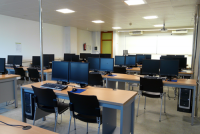ACADEMIA
Formiga Cloud delivers computer classrooms in the cloud
- CESGA, the Electronics and Computers and the Particle Physics Departments at the Universidade de Santiago de Compostela (USC) have developed a pioneering project in the "recycling" of computer resources.
- Formiga (Ant in English) Cloud can get more computers into classrooms by using them in a shared mode.
- It was necessary to use advanced scheduling algorithms including artificial intelligence techniques based on neural networks.
Today many institutions such as universities, colleges, schools, colleges and various public agencies have computer rooms in which they accumulate a lot of computers. The Supercomputing Center of Galicia (CESGA) and the Departments of Electronics and Computer Science and Particle Physics at USC are working on creating a cloud formed by all these computers called the Formiga (Ant in English) Cloud project.
Increasingly common in most scientific disciplines using supercomputer simulations, it is widespread in the areas of Genomic Medicine, Biotechnology, Climatology, etc.... However, "at present and given the current economic situation, it is difficult to acquire new computing platforms, so the reuse of existing computational resources is required,"said Javier Lopez Cacheiro, project director Formiga CLOUD, Senior Technical Systems CESGA. The Formiga Cloud allows for better use of existing resources in the computer classrooms, facilitating the delivery of courses like conducting scientific simulations, and using remote computers.
Making the most of existing resources
The project consists in building a cloud platform using the computers in computer classrooms or any other facility. Although initially it was to leverage these underutilized resources to give researchers more computing power, Formiga Cloud will also enable the use of cloud infrastructure for the delivery of courses.
With this platform, the teacher has much more flexibility when configuring the equipment and creating the right environment to teach the subject. They can deploy virtual machines on which students can modify the system where you are doing the course, without fear of affecting the setting of the classroom. In this virtual computer, previously created by the teacher, it is possible not only to connect remotely from the computer classrooms but also from students' personal computers. Similarly, they can be in your storage devices a copy of the virtual computer and work with it on their own computer.
Formiga Cloud will also enable students in classrooms that have modest equipment to conduct their practices easily on more powerful remote machines, without having to physically change the classroom, thereby increasing the reuse of resources. "We try to get the maximum return on investments made in the computer labs," says Lopez Cacheiro.
Supercomputing in the Computer Classroom
Researchers also may use the Formiga Cloud to accelerate the completion of scientific simulations. It should be noted that only the University of Santiago has more than 1,800 computers that could be used in shared mode for courses and to perform simulations. Just "one of the main challenges of the project was to develop a new scheduler to take into account the special characteristics of computers in classrooms, unlike what happens in traditional cloud platforms, not only are they not available exclusively for platform but they also can be turned off at any time for students." This necessitated the use of new scheduling algorithms including more advanced artificial intelligence techniques based on neural networks. It assesses the historical availability of each of the computers in a classroom and on the basis of this data, then it makes predictions for future availability. They are using these predictions to evaluate which computer is the best to run a particular simulation job.
The Formiga Cloud project is funded by the Xunta de Galicia (09TIC001CT).
The first prototype of the project and is available at: http://formigacloud.cesga.es
